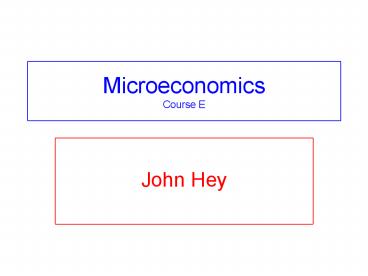Microeconomics Course E - PowerPoint PPT Presentation
1 / 19
Title:
Microeconomics Course E
Description:
... will be useful when we examine duopoly. GAMES. In general many players and ... When we consider duopoly, the two players do not choose just from two choices ... – PowerPoint PPT presentation
Number of Views:124
Avg rating:3.0/5.0
Title: Microeconomics Course E
1
MicroeconomicsCourse E
- John Hey
2
Chapter 30
- GAME THEORY
- Up to now we have considered situations in which
individuals take decisions independently of the
decisions of others. - Today we consider situations of interdependence
games. - It will be useful when we examine duopoly.
3
GAMES
- In general many players and many decisions.
- We start by considering games in which there are
two players (1 and 2) each with two decisions (A
and B). - Their payoffs depend on the decisions of both
players.
4
(No Transcript)
5
A Dominating Choice
- A player has a dominating choice if it is best
independently of the choice of the other player.
6
(No Transcript)
7
A Nash Equilibrium
- A combination of choices in a game is called a
Nash equilibrium if neither player wants to
change his or her choice given the choice of the
other player. - Does a Nash Equilibrium always exist?
8
(No Transcript)
9
(No Transcript)
10
(No Transcript)
11
Pareto Dominance
- When one outcome is better for both players than
some other outcome, we say that the first outcome
Pareto Dominates the second. - We note that the Nash Equilibrium (AA) in the
Prisoners Dilemma is Pareto Dominated by BB.
12
A Continuum of Choices
- When we consider duopoly, the two players do not
choose just from two choices but choose the value
of some variable. - We have exactly the same concepts.
13
(No Transcript)
14
(No Transcript)
15
(No Transcript)
16
(No Transcript)
17
Chapter 30
- A player has a dominating choice if this choice
is best independently of the choice of the other. - A combination of choices in a game is called a
Nash equilibrium if neither player wants to
change his or her choice given the choice of the
other player - Games may have no Nash Equilibria (in pure
strategies), a unique Nash Equilibrium of several
Nash equilibria.
18
Chapter 30
- Goodbye!
19
(No Transcript)



























![⚡Read✔[PDF] Microeconomics: Private & Public Choice (MindTap Course List) 17th Edition PowerPoint PPT Presentation](https://s3.amazonaws.com/images.powershow.com/10090948.th0.jpg?_=20240802129)


![[DOWNLOAD]⚡️PDF✔️ Principles of Microeconomics Third Edition PowerPoint PPT Presentation](https://s3.amazonaws.com/images.powershow.com/10098785.th0.jpg?_=202408140210)
![[PDF] DOWNLOAD Principles of Microeconomics Third Edition PowerPoint PPT Presentation](https://s3.amazonaws.com/images.powershow.com/10099598.th0.jpg?_=202408150410)